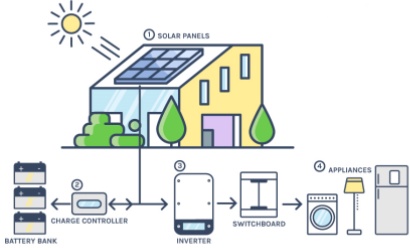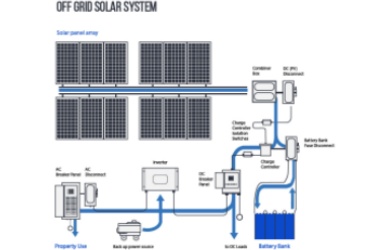Revealing the Off-Grid Solar Inverter: The wisdom and power of solar off-grid inverters
As the world's focus on renewable energy continues to increase, solar power generation is increasingly used in various fields. Among them, Off Grid Solar Inverter, as a special inverter, converts the DC power generated by solar panels into AC power, operates independently of the power grid, and provides a solution for power supply in off-grid or remote areas. This article will introduce Off Grid Solar Inverter, including its definition, characteristics, application fields, installation and use methods, and prospects.
Off-Grid Solar Inverter Definition and Features
The Grid Solar Inverter, which is sometimes referred to as an off-grid solar inverter, is a piece of equipment that alters the direct current produced by solar panels into alternating current. It does not need to be connected to the primary grid but operates independently, converting solar energy into a reliable power supply. Off Grid Solar Inverter has the following features:
1. Efficiency: The inverter adopts an efficient circuit design and optimization algorithm to maximize the power conversion efficiency.
2. Stability: Provide stable, high-quality power output to meet various power needs.
3. Independence: No need to rely on the power grid, which plays a vital role in off-grid or remote areas.
4. Flexibility: Can be used with different specifications of solar panels and energy storage batteries to meet various power needs.
5. Environmental protection: Using renewable energy to reduce dependence on traditional energy benefits environmental protection.
Application fields of Off-Grid Solar Inverter
Grid Solar Inverter is widely used in homes, businesses, industries, public facilities, and agricultural fields. It has become a pivotal device to solve power supply problems in remote and off-grid areas. By converting solar energy into alternating current, Off Grid Solar Inverter provides people with a reliable power supply and contributes to global sustainable development.

How to install and use a Grid Solar Inverter?
Installing and using the Off Grid Solar Inverter requires specific skills and knowledge. Here are the general steps and considerations:
1. Selection and planning: Select the appropriate inverter model and specifications based on power demand, sunlight conditions, and budget. Also, consider the overall system design and layout to ensure maximum solar energy utilization.
2. Installation location selection: Choose a well-ventilated, wind-sheltered, sunny location to install the inverter. At the same time, ensure that the device is installed securely to prevent accidental dropping or theft.
3. Cable connection: Select the appropriate cable for reference according to the input and output specifications of the inverter. Ensure the cable types match and the link is firm to avoid poor contact or short circuit.
4. Operation and use: Operate and use according to the instructions of the inverter. Set the inverter parameters and options correctly, such as output voltage, frequency, etc. At the same time, pay attention to daily inspection and maintenance and find and solve problems in time.
5. Safety protection: Ensure the environment's safety around the inverter and prevent children or other persons from coming into contact with the inverter. At the same time, regularly check the operating status and temperature of the inverter to avoid overheating or overloading.
Routine maintenance and upkeep of off-grid solar inverter
Routine maintenance and care are crucial to ensure the Off Grid Solar Inverter's regular operation and extended service life. Here are some suggestions:
1. Regularly check whether the cable connection is firm to prevent poor contact or short circuit.
2. Clean the surface of the inverter and the surrounding environment regularly to maintain good heat dissipation.
3. Check the operating status and temperature of the inverter to prevent overheating or overloading.
4. Regularly conduct battery management and energy storage optimization to ensure the continuity of power supply.
5. Pay attention to waterproof and dustproof protection to avoid the impact of moisture and dust on the inverter.
6. Regularly back up and update the software system to ensure the regular operation and safety of the inverter.
7. When encountering a fault or abnormal situation, stop the machine promptly for inspection and contact professionals for repair.

Off-grid solar inverter price
With the continuous advancement of technology and the popularization of renewable energy, Off Grid Solar Inverter's technology will be further developed and optimized. In the future, it may have higher conversion efficiency, lower costs, more intelligent management functions, and a more comprehensive range of applications. At the same time, with the increasing global emphasis on environmental protection and sustainable development, the application prospects of Off Grid Solar Inverter will be broader. It will become one of the critical forces driving the global energy transition in various fields, such as households, commerce, industry, public facilities, and agriculture. If you want to know more about the latest news about off-grid solar inverters or wish to purchase off-grid solar inverters, you can contact us to initiate an inquiry.
Off-grid solar inverter suppliers
PDDN Photoelectron Technology Co., Ltd. is a high-tech enterprise focusing on the manufacturing, R&D, and selling of power semiconductor devices. Since its establishment, the company has been committed to providing high-quality, high-performance semiconductor products to customers worldwide to meet the needs of the evolving power electronics industry.
It accepts payment via Credit Card, T/T, West Union, and Paypal. PDDN will ship the goods to customers overseas through FedEx, DHL, by sea, or by air. If you are looking for a high-quality, off-grid solar inverter, please send us inquiries; we will be here to help you.
